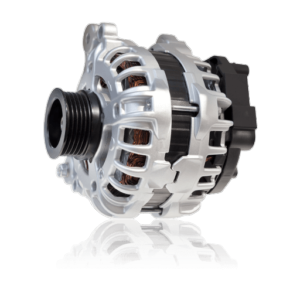Alternator
SELECT YOUR VEHICLE TO FIND THE RIGHT PARTS!

All you need to know about the Generator
Modern vehicles are expected to meet strict requirements, e.g., in terms of energy efficiency among others, as a result of which the electrical network of the vehicles tends to become more advanced. For the advanced electrical networks, the vehicle manufacturers design state of art generators.
The generator is composed of an excited rotor and a stator having a multiple winding system. Its function is to convert the kinetic energy of the rotating crankshaft to electricity. The created energy is used for charging the battery and for supplying power to the various electrical devices during the operation of the engine. In certain cases, it also has a role in starting the engine, and it facilitates the engine in case of situations requiring high torque.
Types of generators:
- Carbon brush
- Without carbon brush
Signs of faults
- V-belt is broken or loose, which is accompanied usually by a whistling sound.
- The battery monitoring light is on during driving.
- Headlights are dim.
- A characteristic humming sound comes from the engine compartment.
Reasons of faults
- May cause the burning of the bridge:
- Water, oil or other dirt is on the circuit board of the diode bridge.
- If the polarity of the connection is reversed.
- The reversed polarity is dangerous to a number of generator parts:
- Bridge
- Voltage regulator
- The tightening rollers installed negligently or not tightened properly, as well as the negligently installed V-belt pulley can cause faults.
- The brushes become faulty because of normal wear and tear.
FAQ
Look around in the help center.
What can we do to keep the generator running?
You can avoid premature component failure by following the simple recommendations below:
Avoid water-filled depressions on the road, or slow down before driving through them. The generator may fail due to moisture on its surface.
When cleaning the space under the hood, protect the generator and other electrical components from water with polyethylene film.
Always use a torque wrench to tighten fasteners.
Avoid installing additional electrical devices to protect the car's power supply system from overloading.
Malfunction and control of the generator
The first step in checking the unit is to look at its condition. Its cover must not have cracks and dents, and the V-belt must not have critical scratches and damaged parts. There should be no bent wires or sparks at the connections to the terminals.
The next step is to measure the voltage at the battery terminals, for which you will need a multimeter. The voltage should be 12.5-12.7V when the engine is not running, or 13.8-14.5V when the engine is running but the electrical equipment is not on. Under load, with the air conditioner, headlights, heater and window heater on, the normal voltage is at least 13.7-14.0V.
If a fault is found, remove and disassemble the part. The degree of wear of the brushes can be estimated from their height, and the diameter of the contact rings must be measured. Also measure the resistance of the rotor and stator windings and the diode bridge to see if there is an open circuit. Compare the measured values with the data specified in the car's technical documentation.
